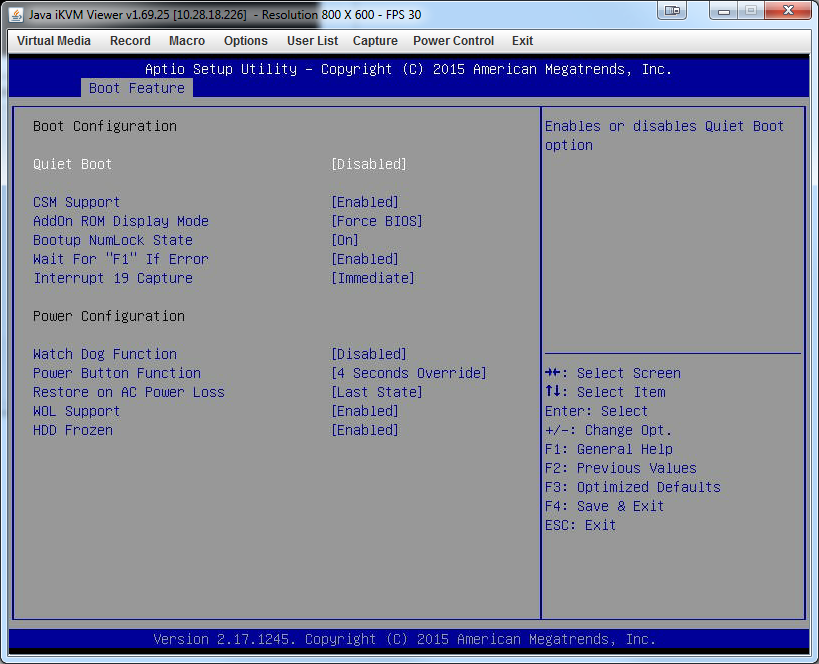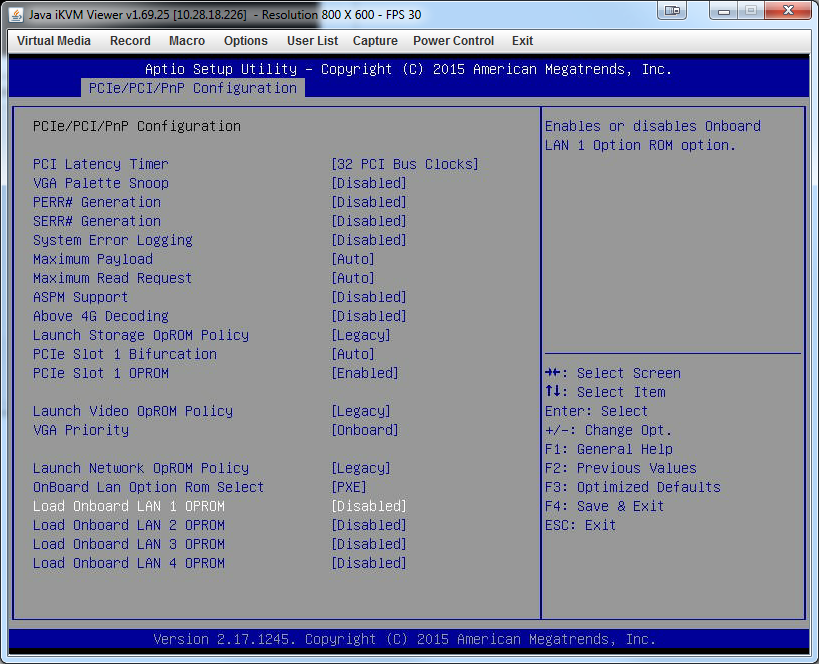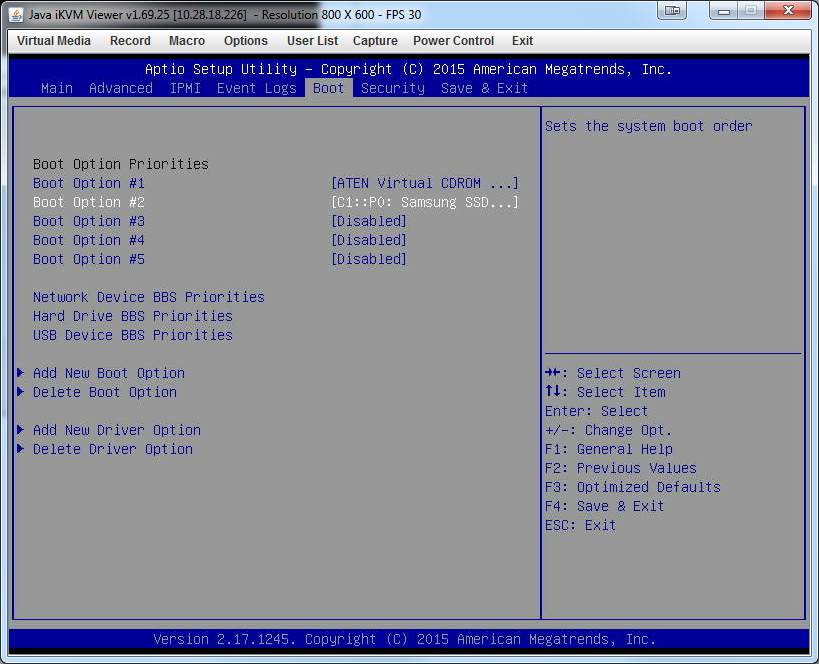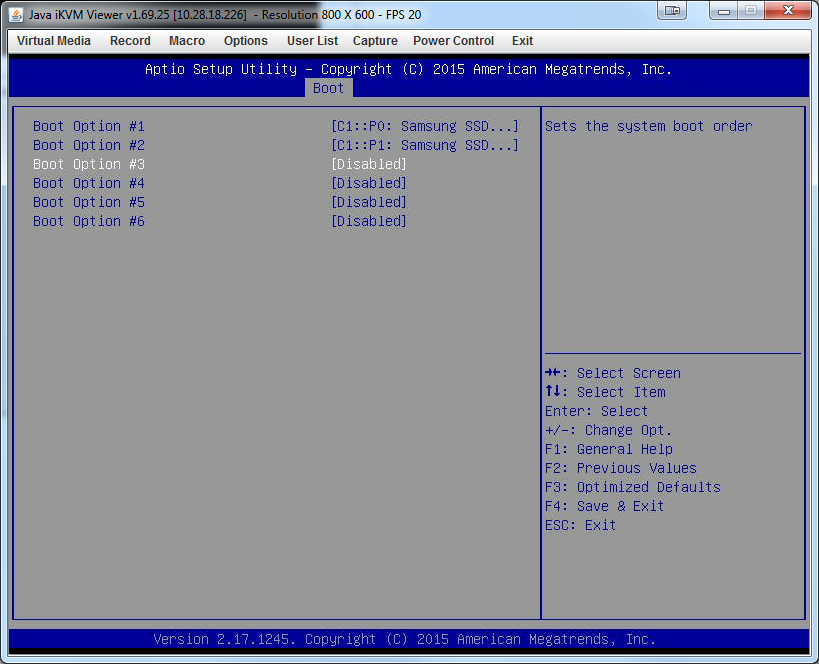Building the XNAT Relays
This is a verbose documentation of the build process used to assemble and build the DICOM and RAW data relays used for the Lifespan studies.
This content may be partially complete
Server Setup
Hardware
- Set boot disk(s) to the SSDs and disable spinning disks from booting
- Label disks using XNAT DICOM/RAW Relay Build
- Label network ports XNAT DICOM/RAW Relay Build
BIOS Settings
Boot Features

PCIe/PCI/PnP Configuration
- Turn off LAN OPROM on all ports

Set the boot order

Set Hard Drive BBS Priorities
Set boot to the C1::P0: and C1::P1: attached SSD and disable booting from the data disks.

Operating System
CentOS 7 - Graphical Server install
- Use manual partitioning
- Select SSD and auto generate legacy layout
- Delete the /home partition (This space will be used for ZFS cache)
- Set timezone to US/Central (Chicago)
- Turn on network time
- Create hcpadmin user
- Set root password (needed if runlevel 1 is necessary)
Install additional packages
Packages
BASHyum install httpd tomcat mutt pgadmin3 httpd-devel gcc gcc-c++ make libtool apxs mod_ssl xinetd tree
- Use manual partitioning
ZFS
Install ZFS
Install ZFS
BASHyum -y install epel-release yum -y install http://download.zfsonlinux.org/epel/zfs-release.el7_3.noarch.rpm # Disable DKMS and enable KMOD vim /etc/yum.repos.d/zfs.repo yum -y install zfs zfs-dracut yum updateReboot to apply updated kernel
Create /etc/zfs/vdev_id.conf with the following contents:
vdev_id.conf
BASHalias disk1 pci-0000:00:17.0-ata-1.0 alias disk2 pci-0000:00:17.0-ata-2.0 alias disk3 pci-0000:00:17.0-ata-3.0 alias disk4 pci-0000:00:17.0-ata-4.0 alias ssd1 pci-0000:00:18.0-ata-1.0 alias ssd2 pci-0000:00:18.0-ata-2.0- Reboot to populate /dev/disk/by-vdev
Create the zpool and set it up.
Create zpool
BASHzpool create -f relaypool raidz2 disk1 disk2 disk3 disk4 zfs set compression=lz4 relaypool zfs set sync=disabled relaypool zfs create relaypool/zfs_tools zfs create -o mountpoint=/raw relaypool/raw zfs create relaypool/raw/data zfs create relaypool/raw/scripts zfs create -o mountpoint=/xnat relaypool/xnat zfs create relaypool/xnat/archive zfs create relaypool/xnat/prearchive zfs create relaypool/xnat/tmp zfs create relaypool/xnat/build zfs create relaypool/xnat/cache zfs create relaypool/xnat/logs zfs create relaypool/xnat/home zfs create -p relaypool/xnat/pgsql/9.4 zfs create relaypool/rpool_backup zfs set reservation=100G relaypool/zfs_tools zfs set quota=7T relaypool zfs set edu.wustl.nrg:quotareports=2 relaypool zfs set edu.wustl.nrg:quotareport:1="2T|warning|relay-ops@nrg.wustl.edu|2d" relaypool zfs set edu.wustl.nrg:quotareport:2="512G|critical|relay-ops@nrg.wustl.edu|12h" relaypool # Make pool auto import and mount on boot systemctl enable zfs-import-cache.service systemctl enable zfs-mount.service # Enable ZFS event daemon systemctl enable zfs-zed.serviceReboot the system so the kernel is familiar with the changes.
Limit ARC to 1/2 the system ram. (Assuming 16GB ram installed)
Limit ARC
BASHecho "options zfs zfs_arc_max=8589934592" >> /etc/modprobe.d/zfs.conf echo "8589934592" > /sys/module/zfs/parameters/zfs_arc_maxInstall OZMT and create snapshot jobs
Install OZMT
BASHyum install mercurial cd /opt hg clone https://bitbucket.org/ozmt/ozmt cd ozmt ./install-ozmt.sh ozmt-snapjobs-add.sh relaypool/raw/scripts daily/7 weekly/4 monthly/3 ozmt-snapjobs-add.sh relaypool/raw/data hourly/6 daily/1 ozmt-snapjobs-add.sh relaypool/zfs_tools hourly/12 daily/7 weekly/4 monthly/3 ozmt-snapjobs-add.sh relaypool/xnat/archive hourly/6 daily/1 ozmt-snapjobs-add.sh relaypool/xnat/prearchive hourly/6 daily/1 ozmt-snapjobs-add.sh relaypool/xnat/home daily/7 weekly/4 ozmt-snapjobs-add.sh relaypool/xnat/logs daily/7 weekly/4 monthly/6 ozmt-snapjobs-add.sh relaypool/xnat/pgsql/9.4 daily/7 weekly/4 monthly/6Scrub the pool daily
Add to root's crontab:Scrub zpool
BASH# Scrub the zpool 0 10 * * * /sbin/zpool scrub relaypool 1 10 * * * /sbin/zpool scrub rpoolComment out the replication jobs in root's crontab:
Disable ZFS Replication
BASH#* * * * * /opt/ozmt/replication/schedule-replication.sh #1,11,21,31,41,51 * * * * /opt/ozmt/replication/replication-job-runner.sh #5,15,25,35,45,55 * * * * /opt/ozmt/replication/replication-job-cleaner.sh
ZFS root
Setup second SSD
Setup rpool
BASHsgdisk -a1 -n2:34:2047 -t2:EF02 /dev/disk/by-vdev/ssd2 sgdisk -n9:-8M:0 -t9:BF07 /dev/disk/by-vdev/ssd2 # rpool sgdisk -n1:0:40G -t1:BF01 /dev/disk/by-vdev/ssd2 # cache sgdisk -n3:0:+40G -t3:BF01 /dev/disk/by-vdev/ssd2 # swap sgdisk -n4:0:+8G -t4:8200 /dev/disk/by-vdev/ssd2 zpool create -f -d -o feature@async_destroy=enabled -o feature@empty_bpobj=enabled \ -o feature@lz4_compress=enabled -o ashift=12 -O compression=lz4 -O canmount=off \ -O mountpoint=/ -R /mnt/rpool \ rpool /dev/disk/by-vdev/ssd2-part1 zfs create -o canmount=off -o mountpoint=none rpool/ROOT zfs create -o canmount=noauto -o mountpoint=/ rpool/ROOT/centos zfs mount rpool/ROOT/centos zfs create -o setuid=off rpool/home zfs create -o mountpoint=/root rpool/home/root zfs create -o canmount=off -o setuid=off -o exec=off rpool/var zfs create -o com.sun:auto-snapshot=false rpool/var/cache zfs create rpool/var/log zfs create rpool/var/spool zfs create -o com.sun:auto-snapshot=false -o exec=on rpool/var/tmp zfs create -o mountpoint=/owncloud rpool/owncloud mkdir /mnt/tmp mount --bind / /mnt/tmp rsync -avhX --stats /mnt/tmp/. /mnt/rpool/. rsync -avhX --stats /boot/. /mnt/rpool/boot/. for dir in proc sys dev;do mount --rbind /$dir /mnt/rpool/$dir;done chroot /mnt/rpool /bin/bash --login cd /dev;ln -s /dev/disk/by-vdev/* .;cd rm /etc/zfs/zpool.cacheComment out all mounts in /etc/fstab
/etc/fstab
BASH# # /etc/fstab # Created by anaconda on Mon Oct 31 10:11:52 2016 # # Accessible filesystems, by reference, are maintained under '/dev/disk' # See man pages fstab(5), findfs(8), mount(8) and/or blkid(8) for more info # #UUID=0078e373-f435-4b66-b08d-df5cf1300554 / xfs defaults 0 0 #UUID=c952f347-1ebe-49eb-be3d-213f8f69f37d /boot xfs defaults 0 0 #UUID=fa96a497-bbd0-42ef-9507-1c6b6a27586a swap swap defaults 0 0Add two lines to /etc/default/grub
/etc/default/grub
BASHGRUB_CMDLINE_LINUX="crashkernel=auto boot=zfs rpool=rpool bootfs=rpool/ROOT/centos zfsforce=1" GRUB_PRELOAD_MODULES="part_gpt zfs"You might need to comment-out GRUB_HIDDEN_TIMEOUT so you get grub menu during boot. This is needed to be able to select other boot entries.
#GRUB_HIDDEN_TIMEOUT=0
Generate new grub config, and verify it has the correct root entry
grub config
BASHgrub2-mkconfig -o /boot/grub2/grub.cfg grep ROOT /boot/grub2/grub.cfg grub2-install /dev/disk/by-vdev/ssd2Enable ZFS services
BASHsystemctl enable zfs-import-cache systemctl enable zfs-import-scan systemctl enable zfs-mount systemctl enable zfs-share systemctl enable zfs-zed systemctl enable zfs.targetAdd zfs to the list of modules dracut should include by default to /etc/dracut.conf
/etc/dracut.conf
BASH# PUT YOUR CONFIG HERE OR IN separate files named *.conf # in /etc/dracut.conf.d # SEE man dracut.conf(5) # Sample dracut config file #logfile=/var/log/dracut.log #fileloglvl=6 # Exact list of dracut modules to use. Modules not listed here are not going # to be included. If you only want to add some optional modules use # add_dracutmodules option instead. #dracutmodules+="" # dracut modules to omit #omit_dracutmodules+="" # dracut modules to add to the default add_dracutmodules+="zfs" # additional kernel modules to the default #add_drivers+="" # list of kernel filesystem modules to be included in the generic initramfs #filesystems+="" # build initrd only to boot current hardware #hostonly="yes" # # install local /etc/mdadm.conf #mdadmconf="no" # install local /etc/lvm/lvm.conf #lvmconf="no" # A list of fsck tools to install. If it's not specified, module's hardcoded # default is used, currently: "umount mount /sbin/fsck* xfs_db xfs_check # xfs_repair e2fsck jfs_fsck reiserfsck btrfsck". The installation is # opportunistic, so non-existing tools are just ignored. #fscks="" # inhibit installation of any fsck tools #nofscks="yes" # mount / and /usr read-only by default #ro_mnt="no" # set the directory for temporary files # default: /var/tmp #tmpdir=/tmpRebuild initramfs
Rebuild initramfs
CODEdracut -f -v /boot/initramfs-$(uname -r).img $(uname -r)Setup links in /dev on each boot
chmod +x /etc/rc.local
vim /etc/rc.local/etc/rc.local
BASH#!/bin/bash # THIS FILE IS ADDED FOR COMPATIBILITY PURPOSES # # It is highly advisable to create own systemd services or udev rules # to run scripts during boot instead of using this file. # # In contrast to previous versions due to parallel execution during boot # this script will NOT be run after all other services. # # Please note that you must run 'chmod +x /etc/rc.d/rc.local' to ensure # that this script will be executed during boot. touch /var/lock/subsys/local cd /dev;ln -s /dev/disk/by-id/* .Setup ZED
Edit /etc/zfs/zed.d/zed.rc:ZED
BASH## # zed.rc # # This file should be owned by root and permissioned 0600. ## ## # Absolute path to the debug output file. # #ZED_DEBUG_LOG="/tmp/zed.debug.log" ## # Email address of the zpool administrator for receipt of notifications; # multiple addresses can be specified if they are delimited by whitespace. # Email will only be sent if ZED_EMAIL_ADDR is defined. # Disabled by default; uncomment to enable. # ZED_EMAIL_ADDR="root nrg-admin@nrg.wustl.edu" ## # Name or path of executable responsible for sending notifications via email; # the mail program must be capable of reading a message body from stdin. # Email will only be sent if ZED_EMAIL_ADDR is defined. # #ZED_EMAIL_PROG="mail" ## # Command-line options for ZED_EMAIL_PROG. # The string @ADDRESS@ will be replaced with the recipient email address(es). # The string @SUBJECT@ will be replaced with the notification subject; # this should be protected with quotes to prevent word-splitting. # Email will only be sent if ZED_EMAIL_ADDR is defined. # ZED_EMAIL_OPTS="-s '@SUBJECT@' @ADDRESS@" ## # Default directory for zed lock files. # #ZED_LOCKDIR="/var/lock" ## # Minimum number of seconds between notifications for a similar event. # ZED_NOTIFY_INTERVAL_SECS=3600 ## # Notification verbosity. # If set to 0, suppress notification if the pool is healthy. # If set to 1, send notification regardless of pool health. # ZED_NOTIFY_VERBOSE=1 ## # Pushbullet access token. # This grants full access to your account -- protect it accordingly! # <https://www.pushbullet.com/get-started> # <https://www.pushbullet.com/account> # Disabled by default; uncomment to enable. # #ZED_PUSHBULLET_ACCESS_TOKEN="" ## # Pushbullet channel tag for push notification feeds that can be subscribed to. # <https://www.pushbullet.com/my-channel> # If not defined, push notifications will instead be sent to all devices # associated with the account specified by the access token. # Disabled by default; uncomment to enable. # #ZED_PUSHBULLET_CHANNEL_TAG="" ## # Default directory for zed state files. # #ZED_RUNDIR="/var/run" ## # Replace a device with a hot spare after N checksum errors are detected. # Disabled by default; uncomment to enable. # #ZED_SPARE_ON_CHECKSUM_ERRORS=10 ## # Replace a device with a hot spare after N I/O errors are detected. # Disabled by default; uncomment to enable. # #ZED_SPARE_ON_IO_ERRORS=1 ## # The syslog priority (e.g., specified as a "facility.level" pair). # #ZED_SYSLOG_PRIORITY="daemon.notice" ## # The syslog tag for marking zed events. # #ZED_SYSLOG_TAG="zed"Create swap space
Setup swap space
BASHmkswap /dev/disk/by-vdev/ssd2-part4 echo "/dev/disk/by-vdev/ssd2-part4 swap swap defaults 0 0" >> /etc/fstab- Reboot
Enter BIOS and change boot to ZFS root disk
(Missing attachment)
Confirm zfs root is running properly
List zpool status and zfs
Check ZFS
CODE# zpool status pool: rpool state: ONLINE status: Some supported features are not enabled on the pool. The pool can still be used, but some features are unavailable. action: Enable all features using 'zpool upgrade'. Once this is done, the pool may no longer be accessible by software that does not support the features. See zpool-features(5) for details. scan: none requested config: NAME STATE READ WRITE CKSUM rpool ONLINE 0 0 0 ata-Samsung_SSD_750_EVO_120GB_S33MNB0H911742A-part1 ONLINE 0 0 0 errors: No known data errors # zfs list NAME USED AVAIL REFER MOUNTPOINT rpool 4.96G 33.5G 136K / rpool/ROOT 4.53G 33.5G 136K none rpool/ROOT/centos 4.53G 33.5G 4.39G / rpool/home 4.97M 33.5G 156K /home rpool/home/hcpadmin 4.04M 33.5G 3.85M /home/hcpadmin rpool/home/root 712K 33.5G 540K /root rpool/var 433M 33.5G 136K /var rpool/var/cache 413M 33.5G 412M /var/cache rpool/var/log 17.4M 33.5G 16.8M /var/log rpool/var/spool 1.70M 33.5G 1.19M /var/spool rpool/var/tmp 876K 33.5G 604K /var/tmp # zfs list -o name,mounted,mountpoint NAME MOUNTED MOUNTPOINT rpool no / rpool/ROOT no none rpool/ROOT/centos yes / rpool/home yes /home rpool/home/hcpadmin yes /home/hcpadmin rpool/home/root yes /root rpool/var no /var rpool/var/cache yes /var/cache rpool/var/log yes /var/log rpool/var/spool yes /var/spool rpool/var/tmp yes /var/tmp # Confirm swap is mounted # free total used free shared buff/cache available Mem: 16405364 905724 14940016 9152 559624 14992148 Swap: 8388604 0 8388604If any zfs folders are not mounted besides rpool, rpool/ROOT and rpool/home these need to be corrected before proceeding.
Setup mirror to original SSD
Re-import relaypool
zpool import
BASHzpool import relaypoolDelete all partitions from original SSD
fdisk
BASHfdisk /dev/disk/by-vdev/ssd1Setup partition
Partition SSD
BASHsgdisk -g -a1 -n2:34:2047 -t2:EF02 /dev/disk/by-vdev/ssd1 sgdisk -n9:-8M:0 -t9:BF07 /dev/disk/by-vdev/ssd1 # rpool sgdisk -n1:0:40G -t1:BF01 /dev/disk/by-vdev/ssd1 # cache sgdisk -n3:0:+40G -t3:BF01 /dev/disk/by-vdev/ssd1 # swap sgdisk -n4:0:+8G -t4:8200 /dev/disk/by-vdev/ssd1Mirror rpool.
First determine the device name of the existing disk.zpool status
BASH# zpool status pool: rpool state: ONLINE status: Some supported features are not enabled on the pool. The pool can still be used, but some features are unavailable. action: Enable all features using 'zpool upgrade'. Once this is done, the pool may no longer be accessible by software that does not support the features. See zpool-features(5) for details. scan: none requested config: NAME STATE READ WRITE CKSUM rpool ONLINE 0 0 0 ata-Samsung_SSD_750_EVO_120GB_S33MNB0H911742A-part1 ONLINE 0 0 0 errors: No known data errorsAttach the other SSD. (Substitute the device name returned from zpool status).
zpool attach
BASH# zpool attach rpool ata-Samsung_SSD_750_EVO_120GB_S33MNB0H911742A-part1 ssd1-part1Wait for the rpool to resilver.
zpool status
BASH# zpool status pool: rpool state: ONLINE status: One or more devices is currently being resilvered. The pool will continue to function, possibly in a degraded state. action: Wait for the resilver to complete. scan: resilver in progress since Wed Nov 30 11:30:23 2016 3.03G scanned out of 4.97G at 73.9M/s, 0h0m to go 3.03G resilvered, 61.06% done config: NAME STATE READ WRITE CKSUM rpool ONLINE 0 0 0 mirror-0 ONLINE 0 0 0 ata-Samsung_SSD_750_EVO_120GB_S33MNB0H911742A-part1 ONLINE 0 0 0 ssd1-part1 ONLINE 0 0 0 (resilvering) errors: No known data errors- Reboot
Re-apply grub setup
grub config
BASHcd /dev;ln -s /dev/disk/by-id/* grub2-mkconfig -o /boot/grub2/grub.cfg grep ROOT /boot/grub2/grub.cfg grub2-install /dev/disk/by-vdev/ssd1 grub2-install /dev/disk/by-vdev/ssd2Create snaphot policies
Snapshots
BASHzfs create -o mountpoint=/rpool/zfs_tools rpool/zfs_tools ozmt-snapjobs-mod.sh rpool/ROOT/centos daily/7 weekly/4 monthly/6 ozmt-snapjobs-mod.sh rpool/home/root daily/7 weekly/4 monthly/6Add additional zfs cache
Additional ZFS cache
BASHzpool add relaypool cache ssd1-part3Add additional swap space
Setup swap space
BASHmkswap /dev/disk/by-vdev/ssd1-part4 echo "/dev/disk/by-vdev/ssd1-part4 swap swap defaults 0 0" >> /etc/fstabswapon -afree
Addition server configuration
Setup email
Preservemain.cfSetup email
BASHcd /etc/postfix mv main.cf main.distCreate new
main.cf. Update as necessary per site.main.cf
BASH# See /usr/share/postfix/main.cf.dist for a commented, more complete version smtpd_banner = $myhostname ESMTP $mail_name biff = no append_dot_mydomain = no # this will add 'POP.yourdomain.tld' to the domain #sender_canonical_maps = regexp:/etc/postfix/sender_regexp # Uncomment the next line to generate "delayed mail" warnings #delay_warning_time = 4h alias_maps = hash:/etc/aliases alias_database = hash:/etc/aliases myorigin = nrg.wustl.edu relayhost = mail.nrg.wustl.edu recipient_delimiter = + inet_interfaces = 127.0.0.1 local_transport = error:local delivery is disabledAdd email alias for root
Setup email
BASHecho "root: nrg-admin@nrg.wustl.edu" >> /etc/aliases newaliasesCreate /etc/ozmt/reporting.muttrc Adjust as necessary.
reporting.muttrc
BASHset realname="lifespan-relay1" set hostname=lifespan-relay1.nrg.mir set from="lifespan-relay1-no-reply@myrealdomain.com" set use_envelope_from=yes set ssl_use_sslv3=no set ssl_use_tlsv1=noSet email_to in /etc/ozmt/config
/etc/ozmt/config
BASH# Address to send reports to email_to="nrg-admin@nrg.wustl.edu"Setup rpool backups
rpool backup
BASHecho "Setup Tomcat for XNAT
Add xnat user
XNAT user
BASHuseradd -c "XNAT system user" -d /xnat/home -s /bin/false xnatFix up /xnat directories
/xnat
BASHcd /xnat mkdir -p logs/{catalina,xnat,tomcat} tmp/{catalina,xnat,tomcat} home/{config,plugins,work} cd home ln -s ../logs/xnat logs ln -s ../tmp/xnat temp cd .. chmod -R g-rx,o-rx . chown -R xnat .Fix up the symlinks in /usr/share/tomcat
/usr/share/tomcat
BASHcd /usr/share/tomcat rm -f temp logs ln -s /xnat/tmp/tomcat temp ln -s /xnat/logs/tomcat logsCreate XNAT Tomcat service
systemctl
BASHsystemctl enable tomcat@xnat.serviceFix up /etc/tomcat/server.xml
Make the Host block matchserver.xml
XML<Host name="localhost" appBase="webapps" unpackWARs="true" autoDeploy="true" xmlValidation="false" xmlNamespaceAware="false"> <!-- SingleSignOn valve, share authentication between web applications Documentation at: /docs/config/valve.html --> <!-- <Valve className="org.apache.catalina.authenticator.SingleSignOn" /> --> <!-- Access log processes all example. Documentation at: /docs/config/valve.html Note: The pattern used is equivalent to using pattern="common" --> <!-- <Valve className="org.apache.catalina.valves.AccessLogValve" directory="logs" prefix="localhost_access_log." suffix=".txt" pattern="%h %l %u %t "%r" %s %b" /> --> </Host>Modify /etc/sysconfig/tomcat
/etc/sysconfig/tomcat
BASH# Service-specific configuration file for tomcat. This will be sourced by # the SysV init script after the global configuration file # /etc/tomcat/tomcat.conf, thus allowing values to be overridden in # a per-service manner. # # NEVER change the init script itself. To change values for all services make # your changes in /etc/tomcat/tomcat.conf # # To change values for a specific service make your edits here. # To create a new service create a link from /etc/init.d/<your new service> to # /etc/init.d/tomcat (do not copy the init script) and make a copy of the # /etc/sysconfig/tomcat file to /etc/sysconfig/<your new service> and change # the property values so the two services won't conflict. Register the new # service in the system as usual (see chkconfig and similars). # # Where your java installation lives #JAVA_HOME="/usr/lib/jvm/java" # Where your tomcat installation lives #CATALINA_BASE="/usr/share/tomcat" CATALINA_HOME="/usr/share/tomcat" #JASPER_HOME="/usr/share/tomcat" CATALINA_TMPDIR="/xnat/tmp/catalina" # You can pass some parameters to java here if you wish to #JAVA_OPTS="-Xminf0.1 -Xmaxf0.3" # Use JAVA_OPTS to set java.library.path for libtcnative.so #JAVA_OPTS="-Djava.library.path=/usr/lib64" JAVA_OPTS="-Xms872m -Xmx2620m -Xmn524m -XX:-OmitStackTraceInFastThrow -XX:MaxPermSize=256m -Dsun.net.inetaddr.ttl=30 -Dxnat.home=/xnat/home" # What user should run tomcat TOMCAT_USER="xnat" # You can change your tomcat locale here #LANG="en_US" # Run tomcat under the Java Security Manager SECURITY_MANAGER="false" # Time to wait in seconds, before killing process SHUTDOWN_WAIT="30" # Whether to annoy the user with "attempting to shut down" messages or not #SHUTDOWN_VERBOSE="false" # Connector port is 8080 for this tomcat instance #CONNECTOR_PORT="8080" # If you wish to further customize your tomcat environment, # put your own definitions here # (i.e. LD_LIBRARY_PATH for some jdbc drivers) TOMCAT_LOG="/xnat/logs/tomcat/catalina.out" CATALINA_OPTS="-Xdebug -Xrunjdwp:transport=dt_socket,server=y,suspend=n,address=8000 -Dcatalina.ext.dirs=/usr/share/tomcat/shared/lib:/usr/share/tomcat/common/lib -Dcom.sun.management.jmxremote -Dcom.sun.management.jmxremote.port=9004 -Dcom.sun.management.jmxremote.authenticate=false -Dcom.sun.management.jmxremote.ssl=false"Edit Tomcat systemd unit. (Change the User line and disable OOM kill)
systemctl edit --full tomcat.service
tomcat@xnat.service
TEXT# Systemd unit file for tomcat instances. # # To create clones of this service: # 0. systemctl enable tomcat@name.service # 1. create catalina.base directory structure in # /var/lib/tomcats/name # 2. profit. [Unit] Description=Apache Tomcat Web Application Container After=syslog.target network.target [Service] Type=simple EnvironmentFile=/etc/tomcat/tomcat.conf Environment="NAME=%I" EnvironmentFile=-/etc/sysconfig/tomcat@%I ExecStart=/usr/libexec/tomcat/server start ExecStop=/usr/libexec/tomcat/server stop SuccessExitStatus=143 User=xnat Group=tomcat # Disable OOM kill on tomcat OOMScoreAdjust=-1000 [Install] WantedBy=multi-user.target
Setup PostgreSQL
Install PostgreSQL
PostgreSQL 9.4
BASHyum install -y https://download.postgresql.org/pub/repos/yum/9.4/redhat/rhel-7-x86_64/pgdg-centos94-9.4-3.noarch.rpm yum install -y postgresql94-serverEdit postgresql-9.4.service
systemctl edit --full postgresql-9.4.servicepostgresql-9.4.service
BASH# It's not recommended to modify this file in-place, because it will be # overwritten during package upgrades. If you want to customize, the # best way is to create a file "/etc/systemd/system/postgresql-9.4.service", # containing # .include /lib/systemd/system/postgresql-9.4.service # ...make your changes here... # For more info about custom unit files, see # http://fedoraproject.org/wiki/Systemd#How_do_I_customize_a_unit_file.2F_add_a_custom_unit_file.3F # Note: changing PGDATA will typically require adjusting SELinux # configuration as well. # Note: do not use a PGDATA pathname containing spaces, or you will # break postgresql-setup. [Unit] Description=PostgreSQL 9.4 database server After=syslog.target After=network.target [Service] Type=forking User=postgres Group=postgres # Note: avoid inserting whitespace in these Environment= lines, or you may # break postgresql-setup. # Location of database directory Environment=PGDATA=/xnat/pgsql/9.4 Environment=PGLOG=/xnat/logs/pgsql/pgstartup-9.4.log # Where to send early-startup messages from the server (before the logging # options of postgresql.conf take effect) # This is normally controlled by the global default set by systemd # StandardOutput=syslog # Disable OOM kill on the postmaster OOMScoreAdjust=-1000 ExecStartPre=/usr/pgsql-9.4/bin/postgresql94-check-db-dir ${PGDATA} ExecStart=/usr/pgsql-9.4/bin/pg_ctl start -D ${PGDATA} -s -w -t 300 ExecStop=/usr/pgsql-9.4/bin/pg_ctl stop -D ${PGDATA} -s -m fast ExecReload=/usr/pgsql-9.4/bin/pg_ctl reload -D ${PGDATA} -s # Give a reasonable amount of time for the server to start up/shut down TimeoutSec=300 [Install] WantedBy=multi-user.targetStart Postgres for the first time
Start Postgres
BASHcd /xnat/pgsql chown postgres:postgres 9.4 chmod 755 /xnat cd /xnat/logs mkdir pgsql chown postgres pgsql cd /usr/pgsql-9.4/bin/postgresql94-setup initdb systemctl start postgresql-9.4.serviceSetup posgresql.conf
cd /xnat/pgsql/9.4
mv postgresql.conf postgresql.conf.distpostgresql.conf
BASHmax_connections = 100 shared_buffers = 612MB work_mem = 50MB maintenance_work_mem = 256MB dynamic_shared_memory_type = posix archive_mode = off effective_cache_size = 1225MB log_destination = 'stderr' logging_collector = on log_directory = 'pg_log' log_filename = 'postgresql-%a.log' log_truncate_on_rotation = on log_rotation_age = 1d log_rotation_size = 0 log_min_duration_statement = 30000 log_line_prefix = '< %m >' log_timezone = 'US/Central' datestyle = 'iso, mdy' timezone = 'US/Central' lc_messages = 'en_US.UTF-8' lc_monetary = 'en_US.UTF-8' lc_numeric = 'en_US.UTF-8' lc_time = 'en_US.UTF-8' default_text_search_config = 'pg_catalog.english' standard_conforming_strings = offGive 'postgres' user a password
postgres user password
BASHsu - postgres psql -c "ALTER USER postgres with password '<put your postgres password here>'" exit- Setup pg_hba.conf
Update procedure:
Check the ZFS on Linux wiki for new information before proceeding:
https://github.com/zfsonlinux/zfs/wiki/RHEL-and-CentOS
Remove and re-install zfs for the latest Centos release
yum remove zfs zfs-kmod spl spl-kmod libzfs2 libnvpair1 libuutil1 libzpool2 zfs-release
yum install http://download.zfsonlinux.org/epel/zfs-release.el7_4.noarch.rpm
find /lib/modules/ \( -name "splat.ko" -or -name "zcommon.ko" \
-or -name "zpios.ko" -or -name "spl.ko" -or -name "zavl.ko" -or \
-name "zfs.ko" -or -name "znvpair.ko" -or -name "zunicode.ko" \) \
-exec /bin/rm {} \;Disable [zfs] and enable [zfs-kmod] in the zfs repo:
vim /etc/yum.repos.d/zfs.repo
[zfs]
name=ZFS on Linux for EL7 - dkms
baseurl=http://download.zfsonlinux.org/epel/7.4/$basearch/
enabled=0
metadata_expire=7d
gpgcheck=1
gpgkey=file:///etc/pki/rpm-gpg/RPM-GPG-KEY-zfsonlinux
[zfs-kmod]
name=ZFS on Linux for EL7 - kmod
baseurl=http://download.zfsonlinux.org/epel/7.4/kmod/$basearch/
enabled=1
metadata_expire=7d
gpgcheck=1
gpgkey=file:///etc/pki/rpm-gpg/RPM-GPG-KEY-zfsonlinux
[zfs-source]
name=ZFS on Linux for EL7 - Source
baseurl=http://download.zfsonlinux.org/epel/7.4/SRPMS/
enabled=0
gpgcheck=1
gpgkey=file:///etc/pki/rpm-gpg/RPM-GPG-KEY-zfsonlinux
[zfs-testing]
name=ZFS on Linux for EL7 - dkms - Testing
baseurl=http://download.zfsonlinux.org/epel-testing/7.4/$basearch/
enabled=0
metadata_expire=7d
gpgcheck=1
gpgkey=file:///etc/pki/rpm-gpg/RPM-GPG-KEY-zfsonlinux
[zfs-testing-kmod]
name=ZFS on Linux for EL7 - kmod - Testing
baseurl=http://download.zfsonlinux.org/epel-testing/7.4/kmod/$basearch/
enabled=0
metadata_expire=7d
gpgcheck=1
gpgkey=file:///etc/pki/rpm-gpg/RPM-GPG-KEY-zfsonlinux
[zfs-testing-source]
name=ZFS on Linux for EL7 - Testing Source
baseurl=http://download.zfsonlinux.org/epel-testing/7.4/SRPMS/
enabled=0
gpgcheck=1
gpgkey=file:///etc/pki/rpm-gpg/RPM-GPG-KEY-zfsonlinuxReinstall ZFS:
yum autoremove
yum install zfs zfs-dracut
systemctl preset zfs-import-cache zfs-import-scan zfs-mount zfs-share zfs-zed zfs.target
# Do the system update
yum update
# Re-enable services
systemctl enable zfs-import-cache
systemctl enable zfs-import-scan
systemctl enable zfs-mount
systemctl enable zfs-share
systemctl enable zfs-zed
systemctl enable zfs.targetMake the lastest kernel the default in grub:
grep '^menuentry' /boot/grub2/grub.cfg
vim /etc/default/grub
grub2-mkconfig -o /boot/grub2/grub.cfgTODO:
Setup Nagios Monitoring:
http://www.admin-magazine.com/Archive/2014/22/Nagios-Passive-Checks
References
https://github.com/zfsonlinux/zfs/wiki/RHEL-%26-CentOS
https://github.com/zfsonlinux/zfs/wiki/Ubuntu%2016.04%20Root%20on%20ZFS